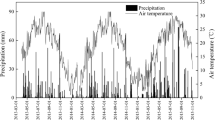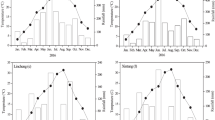Abstract
Controlled release fertilizer can reduce nitrogen losses to the environment while increasing grain yield and improving apparent nitrogen recovery (ANR) of rice. However, few studies have evaluated the comparative efficacy of different polymer-coated urea products on nitrogen (N) losses, ANR, and N uptake of rice. A 2-year field experiment was conducted to compare the effects of three different types of polymer-coated urea fertilizer on nitrogen losses through NH3 volatilization and surface runoff to the environment, ANR, grain yield, and N uptake as compared to conventional urea of rice. Six treatments including (1) control with 0 kg N ha−1 (CK), (2) basal application of urea (Ub), (3) split application (Us) of urea (50% at transplanting, 25% at tillering, and 25% at panicle stages), (4) CRU-1 (polyurethane-coated urea), (5) CRU-2 (degradable polymer-coated urea), and (6) CRU-3 (water-based polymer-coated urea) all applied at 165 kg N ha−1. It was found that CRU-2 resulted in the highest grain yield and panicle numbers among the N fertilization treatments in 2013 and 2014. Applying CRU could help increase N uptake in rice, reduce N losses through NH3 volatilization and surface runoff, and hence improve ANR. Its single dose can meet the nutrient demand of the rice plant. Controlled release urea could be adopted as an effective mitigation alternative to retard N losses through NH3 volatilization and surface runoff while improving ANR of double crop** of late rice.






Similar content being viewed by others
References
Agrium Inc. (2016) ESN smart nitrogen. Available at http://www.smartnitrogen.com/home
Banerjee B, Pathak H, Aggarwal PK (2002) Effects of dicyandiamide, farmyard manure and irrigation on crop yields and ammonia volatilization from an alluvial soil under a rice (Oryza sativa L.)-wheat (Triticum aestivum L.) crop** system. Biol Fert Soils 36:207–214
Bao SD (2000) Soil and agricultural chemistry analysis, 3rd edn. China Agricultural Press, Bei**g
Behera SN, Sharma M, Aneja VP, Balasubramanian R (2013) Ammonia in the atmosphere: a review on emission sources, atmospheric chemistry and deposition on terrestrial bodies. Environ Sci Pollut R 20:8092–8131
Blackshaw RE, Hao X, Brandt RN, Clayton GW, Harker KN, O'Donovan JT, Johnson EN, Vera CL (2011) Canola response to ESN and urea in a four-year no-till crop** system. Agron J 103:92–99
Cai GX, Zhu ZL (1995) Evaluation of gaseous nitrogen losses from fertilizers applied to flooded rice. Acta Pedol Sin 32(Supplement 2):128–135 (in Chinese)
Chen SK, Liu CWI (2002) Analysis of water movement in paddy rice fields (I) experimental studies. J Hydrol 260:206–215
Chen C, Gao ZD, Qiu XY, Hu SW (2013a) Enhancement of the controlled-release properties of chitosan membranes by crosslinking with Suberoyl chloride. Molecules 18:7239–7252
Chen C, Tao SM, Qiu XY, Ren XQ, Hu SW (2013b) Long-alkane-chain modified N-phthaloyl chitosan membranes with controlled permeability. Carbohyd Polym 91:269–276
Chen XP, Cui ZL, Fan MS, Vitousek P, Zhao M, Ma WQ et al (2014) Producing more grain with lower environmental costs. Nature 514:486–489
Connell JA, Hancock DW, Durham RG, Cabrera ML, Harris GH (2011) Comparison of enhanced-efficiency nitrogen fertilizers for reducing ammonia loss and improving Bermudagrass forage production. Crop Sci 51:2237–2248
De Datta SK, Buresh RJ, Obcemea WN, Castillo EG (1990) Nitrogen-15 balances and nitrogen fertilizer use efficiency in upland rice. Fertilizer research 26:179–187
Du CW, Zhou JM, Wang HY (2005) Advance in polymer-coated controlled release fertilizers. Resources and Environment in the Yangtze Basin 14:725–730 (in Chinese with English abstract)
Du CW, Shen YZ, Zhou JM (2013) Application of aqueous silicone-acrylate emulsions in coated controlled release fertilizer. J Control Release 172:e18–e19
Editorial Board of China Agriculture Yearbook (2014) China agriculture yearbook. China Agriculture Press, Bei**g (in Chinese)
Galloway JN, Cowling EB (2002) Reactive nitrogen and the world: 200 years of change. Ambio 31:64–71
Golden BR, Slaton NA, Norman RJ, Wilson CE, DeLong RE (2009) Evaluation of polymer-coated urea for direct-seeded, delayed-flood Rice production. Soil Sci Soc Am J 73:375–383
Grant CA, Wu R, Selles F, Harker KN, Clayton GW, Bittman S, Zebarth BJ, Lupwayi NZ (2012) Crop yield and nitrogen concentration with controlled release urea and split applications of nitrogen as compared to non-coated urea applied at seeding. Field Crop Res 127:170–180
Han K, Zhou CJ, Wang LQ (2014) Reducing ammonia volatilization from maize fields with separation of nitrogen fertilizer and water in an alternating furrow irrigation system. J Integr Agr 13:1099–1112
Hu SW, Qu XY, Tao SM, Zhu DC (2013) Physical and chemical dual-control-type polymer-coated controlled-release fertilizer and preparation method thereof. Google Patents
Hu Z, Liu Y, Huang LY, Peng SB, Nie LX, Cui KH, Huang JL, Wang F (2015) Premature heading and yield losses caused by prolonged seedling age in double crop** rice. Field Crop Res 183:147–155
Ji XH, Zheng SX, Lu YH, Liao YL (2007) Study of dynamics of floodwater nitrogen and regulation of its runoff loss in Paddy field-based two-crop** Rice with urea and controlled release nitrogen fertilizer application. Agr Sci China 6:189–199
Ju XT, **ng GX, Chen XP, Zhang SL, Zhang LJ, Liu XJ, Cui ZL, Yin B, Christie P, Zhu ZL, Zhang FS (2009) Reducing environmental risk by improving N management in intensive Chinese agricultural systems. P Natl Acad Sci Usa 106:3041–3046
Kiran JK, Khanif YM, Amminuddin H, Anuar AR (2010) Effects of controlled release urea on the yield and nitrogen nutrition of flooded Rice. Commun Soil Sci Plan 41:811–819
Liang XQ, Chen YX, Li H, Tian GM, Ni WZ, He MM, Zhang ZJ (2007) Modeling transport and fate of nitrogen from urea applied to a near-trench paddy field. Environ Pollut 150:313–320
Liu TQ, Fan DJ, Zhang XX, Chen J, Li CF, Cao CG (2015) Deep placement of nitrogen fertilizers reduces ammonia volatilization and increases nitrogen utilization efficiency in no-tillage paddy fields in central China. Field Crop Res 184:80–90
Lyu XX, Yang YC, Li YC, Fan XH, Wan YS, Geng YQ, Zhang M (2015) Polymer-coated tablet urea improved Rice yield and nitrogen use efficiency. Agron J 107:1837–1844
Noellsch AJ, Motavalli PP, Nelson KA, Kitchen NR (2009) Corn response to conventional and slow-release nitrogen fertilizers across a Claypan landscape. Agron J 101:607–614
Novoa R, Loomis RS (1981) Nitrogen and plant production. Plant Soil 58:177–204
Peng SB, Buresh RJ, Huang JL, Yang JC, Zou YB, Zhong XH, Wang GH, Zhang FS (2006) Strategies for overcoming low agronomic nitrogen use efficiency in irrigated rice systems in China. Field Crop Res 96:37–47
Peng SB, Buresh RJ, Huang JL, Zhong XH, Zou YB, Yang JC, Wang GH, Liu YY, Hu RF, Tang QY, Cui KH, Zhang FS, Dobermann A (2010) Improving nitrogen fertilization in rice by site-specific N management. A review. Agron Sustain Dev 30:649–656
Rao DLN (1987) Slow-release urea fertilizers-effect on floodwater chemistry, ammonia volatilization and rice growth in an alkali soil. Fertilizer research 13:209–221
Ray DK, Foley JA (2013) Increasing global crop harvest frequency: recent trends and future directions. Environ Res Lett 8
Roberts TL, Norman RJ, Slaton NA, Wilson CE (2009) Changes in alkaline Hydrolyzable nitrogen distribution with soil depth: fertilizer correlation and calibration implications. Soil Sci Soc Am J 73:2151–2158
Rodrigues MÂ, Santos H, Ruivo S, Arrobas M (2010) Slow-release N fertilisers are not an alternative to urea for fertilisation of autumn-grown tall cabbage. Eur J Agron 32:137–143
Schlesinger WH, Hartley AE (1992) A global budget for atmospheric NH3. Biogeochemistry 15:191–211
Shang QY, Gao CM, Yang XX, Wu PP, Ling N, Shen QR, Guo SW (2014) Ammonia volatilization in Chinese double rice-crop** systems: a 3-year field measurement in long-term fertilizer experiments. Biol Fert Soils 50:715–725
Shaviv A (1996) Plant response and environmental aspects as affected by rate and pattern of nitrogen release from controlled release N fertilizers. In Progress in nitrogen cycling studies 285–291
Shaviv A, Mikkelsen RL (1993) Controlled-release fertilizers to increase efficiency of nutrient use and minimize environmental degradation-a review. Fertilizer Research 35:1–12
Shen YZ, Zhao C, Zhou JM, Du CW (2015) Application of waterborne acrylic emulsions in coated controlled release fertilizer using reacted layer technology. Chinese J Chem Eng 23:309–314
Sudhakara K, Prasad R (1986) Ammonia volatilization losses from prilled urea, urea supergranules (USG) and coated USG in rice fields. Plant Soil 94:293–295
Tian YH, Yin B, Yang LZ, Yin SX, Zhu ZL (2007) Nitrogen runoff and leaching losses during Rice-wheat rotations in Taihu Lake region, China. Pedosphere 17:445–456
Trenkel ME (1997) Controlled-release and stabilized fertilizers in agriculture vol 11. International fertilizer industry association, Paris, pp 15–16
Wang ZH, Liu XJ, Ju XT, Zhang FS, Malhi SS (2004) Ammonia volatilization loss from surface-broadcast urea: comparison of vented- and closed-chamber methods and loss in winter wheat-summer maize rotation in North China plain. Commun Soil Sci Plan 35:2917–2939
Wang J, Lu GA, Guo XS, Wang YQ, Ding SW, Wang DZ (2015) Conservation tillage and optimized fertilization reduce winter runoff losses of nitrogen and phosphorus from farmland in the Chaohu Lake region, China. Nutr Cycl Agroecosys 101:93–106
Wang WQ, Chen QA, Hussain S, Mei JH, Dong HL, Peng SB, Huang JL, Cui KH, Nie LX (2016) Pre-sowing seed treatments in direct-seeded early Rice: consequences for emergence, seedling growth and associated metabolic events under chilling stress. Sci Rep 6:19637
Wu W, Nie LX, Liao YC, Shah F, Cui KH, Wang Q, Lian Y, Huang JL (2013) Toward yield improvement of early-season rice: other options under double rice-crop** system in central China. Eur J Agron 45:75–86
**ng B, Carstens LL, Wynnyk NP (2007) Controlled release fertilizer employing epoxidized fatty acid triglyceride oil as a coating additive. Google Patents
Xu GH, Fan XR, Miller AJ (2012a) Plant nitrogen assimilation and use efficiency. Annu Rev Plant Biol 63:153–182
Xu JZ, Peng SZ, Yang SH, Wang WG (2012b) Ammonia volatilization losses from a rice paddy with different irrigation and nitrogen managements. Agric Water Manag 104:184–192
Xu MG, Li DC, Li JM, Qin DZ, Hosen Y, Shen HP, Cong RH, He XH (2013) Polyolefin-coated urea decreases ammonia volatilization in a double Rice system of southern China. Agron J 105:277–284
Xue LH, Yu YL, Yang LZ (2014) Maintaining yields and reducing nitrogen loss in rice-wheat rotation system in Taihu Lake region with proper fertilizer management. Environ Res Lett 9(11pp)
Yan HM, ** intensity in China derived from agro-meteorological observations and MODIS data. Chinese Geogr Sci 24:205–219
Yang YC, Zhang M, Li YC, Fan XH, Geng YQ (2012) Controlled release urea improved nitrogen use efficiency, activities of leaf enzymes, and Rice yield. Soil Sci Soc Am J 76:2307–2317
Yang YC, Zhang M, Li YC, Fan XH, Geng YQ (2013a) Controlled-release urea commingled with rice seeds reduced emission of ammonia and nitrous oxide in rice paddy soil. J Environ Qual 42:1661–1673
Yang YC, Zhang M, Zheng L, Cheng DD, Liu M, Geng YQ, Chen JQ (2013b) Controlled-release urea for Rice production and its environmental implications. J Plant Nutr 36:781–794
Zhao X, Zhou Y, Min J, Wang SQ, Shi WM, **ng GX (2012) Nitrogen runoff dominates water nitrogen pollution from rice-wheat rotation in the Taihu Lake region of China. Agric Ecosyst Environ 156:1–11
Zhu ZL (2000) Loss of fertilizer N from plants-soil system and the strategies and techniques for its reduction. Soil and Environmental sciences 9:1–6 (in Chinese with English abstract)
Zhu ZL, Chen DL (2002) Nitrogen fertilizer use in China-contributions to food production, impacts on the environment and best management strategies. Nutr Cycl Agroecosys 63:117–127
Acknowledgments
This research was supported by the Special Fund for Agro-scientific Research in the Public Interest from the Ministry of Agriculture, China (201303103), and the Fundamental Research Funds for the Central Universities (2662015PY135).
Author information
Authors and Affiliations
Corresponding author
About this article
Cite this article
Li, P., Lu, J., Hou, W. et al. Reducing nitrogen losses through ammonia volatilization and surface runoff to improve apparent nitrogen recovery of double crop** of late rice using controlled release urea. Environ Sci Pollut Res 24, 11722–11733 (2017). https://doi.org/10.1007/s11356-017-8825-8
Received:
Accepted:
Published:
Issue Date:
DOI: https://doi.org/10.1007/s11356-017-8825-8




